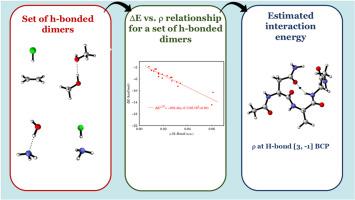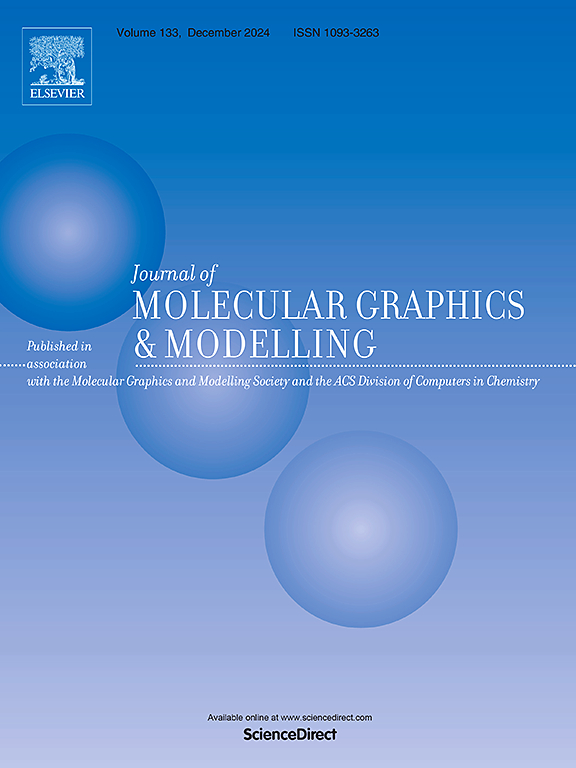评估相互作用能与电子密度的关系,以估算分子间和分子内的氢键。
IF 2.7
4区 生物学
Q2 BIOCHEMICAL RESEARCH METHODS
引用次数: 0
摘要
我们研究了从 19 个分子间 H 键二聚体得到的临界点上的相互作用能(ΔE)和电子密度(ρ)之间关系的计算影响,以估计较大 H 键体系的分子间和分子内相互作用。我们的分析考察了基集叠加误差 (BSSE) 效应、色散能修正以及交换相关能模型对 ΔE 与 ρ 线性回归的影响。计算是在密度泛函理论(DFT)中结合 6-31+G(d,p) 和 def2-TZVPP 基集进行的。这一过程量化了不同近似水平的 BSSE 平均效应,并强调了 ΔE 估计与弥散修正的敏感性。这对于以较低的计算成本开发基于 DFT 的大型 H 键体系多重相互作用能量估算器非常有价值。我们通过分析 DNA 碱基对、天冬酰胺侧链和 AZT 分子等 H 键生物分子应用了这一程序。我们估算的 H 键相互作用能与之前的研究结果一致,并强调了使用 DFT 结合拓扑参数准确预测相互作用能的方法论因素的重要性。本文章由计算机程序翻译,如有差异,请以英文原文为准。

Evaluating interaction energy versus electron density relationships to estimate inter and intramolecular H-bonding
We investigate the computational effects on the relationships between interaction energy (ΔE) and electron density (ρ), at the critical point obtained from 19 intermolecular H-bonded dimers, to estimate inter and intramolecular interactions of larger H-bonded systems. Our analysis examines basis set superposition error (BSSE) effects, dispersion energy corrections, and the exchange-correlation energy model on the ΔE vs. ρ linear regressions. The calculations were carried out within density functional theory (DFT) combined with the 6-31+G(d,p) and def2-TZVPP basis sets. This procedure quantifies the average effects of BSSE for different levels of approximation, and underscore the sensitivity of the ΔE estimation together with dispersion corrections. This is valuable for the development of DFT-based estimators of multiple interaction energies of large H-bonded systems with low computational cost. We have applied this procedure by analyzing H-bonded biological molecules, such as DNA base pairs, an asparagine side chain, and an AZT molecule. Our estimated H-bond interaction energies are in agreement with previous studies, and emphasize the importance of methodological considerations for accurately predicting interaction energies using DFT combined with topological parameters.
求助全文
通过发布文献求助,成功后即可免费获取论文全文。
去求助
来源期刊

Journal of molecular graphics & modelling
生物-计算机:跨学科应用
CiteScore
5.50
自引率
6.90%
发文量
216
审稿时长
35 days
期刊介绍:
The Journal of Molecular Graphics and Modelling is devoted to the publication of papers on the uses of computers in theoretical investigations of molecular structure, function, interaction, and design. The scope of the journal includes all aspects of molecular modeling and computational chemistry, including, for instance, the study of molecular shape and properties, molecular simulations, protein and polymer engineering, drug design, materials design, structure-activity and structure-property relationships, database mining, and compound library design.
As a primary research journal, JMGM seeks to bring new knowledge to the attention of our readers. As such, submissions to the journal need to not only report results, but must draw conclusions and explore implications of the work presented. Authors are strongly encouraged to bear this in mind when preparing manuscripts. Routine applications of standard modelling approaches, providing only very limited new scientific insight, will not meet our criteria for publication. Reproducibility of reported calculations is an important issue. Wherever possible, we urge authors to enhance their papers with Supplementary Data, for example, in QSAR studies machine-readable versions of molecular datasets or in the development of new force-field parameters versions of the topology and force field parameter files. Routine applications of existing methods that do not lead to genuinely new insight will not be considered.
 求助内容:
求助内容: 应助结果提醒方式:
应助结果提醒方式:


